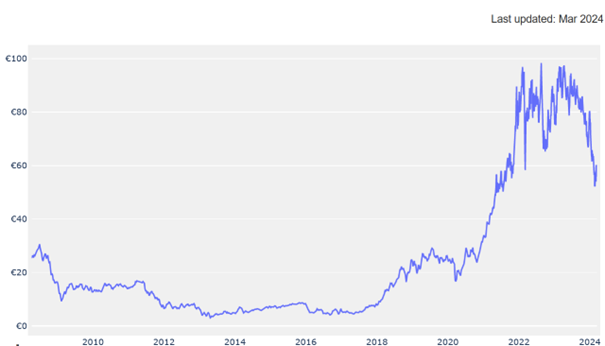The drop in ETS (Emission Trading System) prices through the first quarter of 2024 does not auger well for the stability and predictability most valued by energy users and producers. Some of the price pressure comes from shifts away from fossil fuels and global macroeconomic conditions and related regulatory and market activities have had an effect. Although there are reasons to believe that prices could increase, as the Carbon Removal Certification Framework (CRCF) makes its way through the European Commission one thing is certain: fluctuating prices will be the norm for quite some time. Energy producers will need to prepare themselves to meet this continued uncertainty and at the same time find ways to engage in a dialogue with regulators so that the linkage between the ETS and the CRCF is designed with necessary price stability and desired price levels in mind.
Underlying the decrease in ETS prices experienced at the start of 2024 and continued price fluctuation are some key pressures on the ETS, some of which are of its own making. 2023 saw real gains in a shift away from fossil fuels, which dropped by a record 19% to a record low, making up less than one third of the EU’s electricity generation. Renewables rose to a record 44% share, surpassing 40% for the first time[1]. Good news of course, but it has in turn taken down the price equilibrium of the ETS.
The decline in prices has additional carryover effects. The fall of the title transfer facility (TTF) natural gas reference market price to 25€/MWh, half of what it was a year ago, affects the cost of fuel switching in power generation, which is cheaper when gas prices go down. Until now, the price formation mechanism of the ETS has been mostly the cost of switching from coal to gas in power generation (it is the prime mechanism pushing down ETS verified emissions so far). In the future, when the power generation sector is mostly decarbonised, other price formation mechanisms will need to prevail, like the cost of decarbonisation of some of the emission intensive industrial sectors, like steel or cement manufacturing. This will presumably result in much higher prices, but we are not there yet.
Interestingly, in a global context, EU gas prices remain uncompetitively high when compared to other regions. US gas prices, for example, are currently only about a quarter of what they are in the EU. This imbalance leads potential buyers to shift to more gas price competitive regions of the world, further reducing gas demand in the industrial sector, translating into reduced CO2 emissions from the same sectors and the need for fewer ETS allowances to cover those emissions.
Moreover, other related factors have added further downward pressure on ETS price and overall price stability: a key change to the EU compliance date, increases of available ETS allowances through the integration of the maritime sector and increased auctioning, and the decline in interest rates. In one way or another all change the dynamics of the ETS market, further affecting price stability.
The last ETS review for the phase 2024 to 2030, initially introduced by the Fit for 55 package (FF55) of July 2021, and now adopted, has displaced the compliance date from April to September. This change means the last-minute panic buying movements that ordinarily took place at the start of the year, sometimes supporting prices, will take place over the summer and will be split over a longer period.

https://ember-climate.org/data/data-tools/carbon-price-viewer/
Evolution of ETS prices up to 15 March 2024
Another aspect of the reform of the ETS introduced by the FF55 is the inclusion of the maritime sector starting on 1 January 2024. This action logically brought a corresponding increase of the CAP, the maximum number of ETS allowances made available through auctions or as free allowances each year, even though the first compliance cycle for the maritime industry will only be in September 2025 (when they will be reporting on their 2024 emissions).
Similarly, the partial financing of RePowerEU by advanced auctioning of ETS allowances resulted in more allowances available than previously expected. With the prices going down, even more allowances need to be sold by the authorities to raise the prescribed revenue stream of 20B€.
Finally, 2023 saw a marked rise in interest rates on the financial markets. For the financial institutions and others that are ‘investing’ in EU ETS allowances and holding onto them as a financial asset, high interest rates decrease the attractiveness of this strategy, notably because the cost of borrowing the money needed to buy the allowances has increased. For reference, in 2018 ETS allowances were the best financial performers of all commodities when the price rose after the initial EU Green Deal announcements. The circumstances have now profoundly changed.
Yet there is a general consensus that prices can only increase in the long term. The increase of the linear reduction factor of the CAP, and other modifications introduced by the last reform, mean that the flow of new allowances will completely dry out in 2039, instead of in 2058 before the reform[2]. And barring more reforms of the mechanism, prices should rapidly start to increase, in anticipation of this ‘endgame’ situation. Even the Commission Communication on the 2040 objectives[3] mentions a carbon value of 290€/ton in 2040.
However, this expectation must still be tempered by the consideration of the inclusion of carbon removals in the ETS. The Commission considering a certification mechanism for carbon removals[4], leading to detailed criteria for the acceptance of certain carbon removal techniques, like geological CCS, storage in construction materials or in soils via carbon farming techniques. The links which will be established between these certified carbon removals and the ETS, certainly ‘generating’ additional ETS allowances, are at the same time a solution to the end-game situation and a risk to keep the prices depressed, if too many carbon removal related credits are brought into the system.
The ETS price has been unexpectedly low over the last few months, in part due to its own success in accelerating the transition from fossil fuels, and in part because of systemic and interrelated factors related to the global energy market and regulatory mechanics. Understanding how these forces affect the ETS mechanism and engaging in an informed dialog with the stakeholders involved with the CRCF frameworks will be essential to weather continued uncertainty ahead of what all believe are expected, but not imminent ETS price increases.
[1] Ember, European Electricity Review 2024, https://ember-climate.org/insights/research/european-electricity-review-2024/
[2] https://getready4.eu/approaching-the-ets-endgame-in-europe/
[3] https://ec.europa.eu/info/law/better-regulation/have-your-say/initiatives/13793-EU-climate-target-for-2040_en
[4] https://climate.ec.europa.eu/eu-action/sustainable-carbon-cycles/carbon-removal-certification_en
Author: Pierre Dechamps, Senior Advisor in our Energy & Industrials team, in Brussels.




